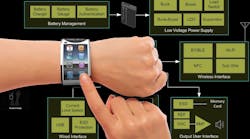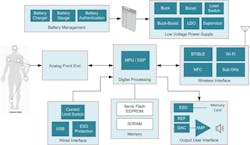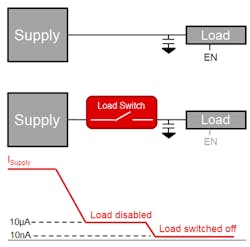The Top Five Engineering Challenges Facing Wearable Medical Devices
Many companies are working on parts of patient monitor networks, if not the entire network. They envision secure connections to wireless networks that let healthcare providers remotely track patients’ progress. Today’s wearable medical products can also act as personal emergency-response systems This lets patients them leave hospitals sooner, eliminates many connectors and cables (not to mention clinic visits) and gives doctors reams of accurate data.
But as usual, there are some hurdles in going from the concept to a profitable product. There are five main design challenges common to patient monitors: power consumption (or battery life), portability (or size), patient safety, secure data delivery, and integration.
Battery Life
Portable and wearable patient monitors are typically battery-powered, and for consumers, battery life is a key purchasing consideration. Battery life is critical because most patient monitors measure and monitor continuously; they are always on. Battery-powered systems require careful partitioning, good use of little space and efficient use of the available charge. Patients and doctors want more features, powered delivered more efficiently in smaller packages and longer times between recharging—a tall order for a battery.
Features such as standby, sleep, power save, hibernate and shutdown help reduce power consumption and extend battery life. Wake-up times and standby power consumption also play vital roles for wireless connectivity.
Designers can specify low-power microcontrollers (MCUs) and analog integrated circuits, but they won’t be able to leverage most of the latest technologies in their design unless they optimize power management. It is important to choose a power architecture that is as efficient as possible and have extended battery run times.
Most designers assume switching controllers or converters contribute to efficiency and low-dropout regulators (LDOs) have poor efficiencies. But LDO topologies have changed; they can provide low dropout voltages. After improving the front-end power path of the battery charger, mid-rail DC/DC converters and LDOs, there is still a way to use a load switch to reduce the shutdown current of any load. For example, a radio module might consume more than 10 µA in deep sleep or hibernation mode. So, a load switch could reduce the shutdown current to just 10 nA. (See graphic below)
Portability or Size
Healthcare wearables include heart-rate monitors, multiparameter patches, continuous blood glucose monitors, handheld pulse oximeters, and fitness and activity monitors. Many of these devices are disposable or use batteries that must be replaced, not recharged. Thus, the battery’s overall form-factor requirements are tight.
Battery size is affected by the type of battery and charging used; the type of buck, boost or buck-boost converters chosen; and the package selection for wireless (or radio-frequency) devices.
There are new devices that have a crystal inside the wireless MCU such as Texas Instrument’s bulk acoustic wave (BAW) devices, which can reliably transmit the patient's vitals. These devices remove the crystal footprint from the printed circuit board, thus decreasing the layout size and easing the layout routing. The smaller packaging can also lead to better integration and save even more space.
Patient Safety
Portable multiparameter patient monitors measure vital signs and use power and data isolation to keep patients safe. Data and power are isolated using digital isolators and isolated power supplies, respectively. There are critical design challenges associated with isolated power and data, including output regulation, feedback mechanisms, input voltage range, output power and size considerations, as well as suitable power architectures. Many newer isolated power modules, such as TI’s miniaturized UCC12050 DC/DC converter, support 500 mW of output power with reinforced isolation.
Secure Data
Wireless medical sensor patches and patient monitors need best-in-class security. Patient data is proprietary information. Data theft is a serious threat.
There are already several security measures designed to protect Intellectual Property (IP) and data sent between patients and doctors. These measures should protect against attacks and secure data transmissions, not only while processing and converting to vital-sign parameters for display, for example, but during transfer as well. This is called over-the-air security.
Integration
How long it takes to develop patient monitors is critical because it also requires many standard lab tests and approvals (both global and regional). It is possible to speed the process with little integration efforts by relying on connectivity to cloud vendors. Uploading patient data directly to the cloud can save space for onboard memory cards.
Code compatibility between platforms such as Bluetooth, Bluetooth Low Energy and Wi-Fi can reduce the coding workload. Integration in terms of multiple cores, universal asynchronous receivers-transmitters, interface standards and several general-purpose inputs/outputs can support a variety of system-level needs and are ready-made interfaces while working with additional processors.
As biomedical designers resolve these challenges and deliver better monitors to market at more affordable prices—and in smaller sizes, but with connectivity—the medical world will rapidly adopt newer patches. From hospitals in developed countries to telemedicine centers in developing countries, to diagnosing injured soldiers in the field, wearables will change the health care landscape and help provide better care.
Sanjay Pithadia is a system engineer in the medical sector of Texas Instruments’ System Engineering and Marketing division.


